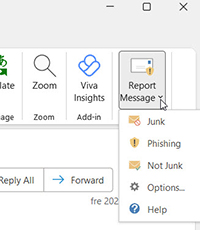Phishing
Phishing is a form of fraud where attackers try to trick people into giving up sensitive information - such as passwords, credit card numbers or other personal data - by posing as a trusted party.
How it works
- Email or message: You receive a message that appears to come from a trusted source, such as your bank, a colleague or a well-known service. The email may contain a previous conversation you were part of that the attacker somehow got hold of.
- Link to fake website: The message often contains a link to a fake website that looks almost identical to the real one.
- File attachment: The message may also contain a file that you are asked to open, which may contain malware.
- Call to action: You are asked to log in, confirm account details or click on an attachment - often with an element of urgency or threat (e.g. "your account will be closed").
Common characteristics
- Spelling mistakes or weird grammar - but sometimes they are very well worded
- Sender address that is not quite right
- Unexpected attachments or links
- Urgent or threatening tone
- Strange demands from colleagues for things you should do
How to protect yourself

- Always check the sender address carefully - not just the name of the sender
- Don't click on links in suspicious messages, if you are concerned about your account in the service the message is coming from, it is better to go directly to that webpage and log in instead of clicking on a link
- Use two-factor authentication
- Report suspicious messages via the menu Report -> Phishing in the top right corner of the opened email. The email will then be deleted and information sent to Microsoft
If you have been exposed
In a stressful situation, it is easy not to think things through. If you accidentally click on a link, open an attachment or otherwise follow instructions in a message that you suspect is a scam, contact the IT department immediately.
Micorsoft has a page with more detailed tips External link, opens in new window. on how to recognize phishing, and they also highlight how to handle phishing messages in Teams and how to report an unsafe website.
